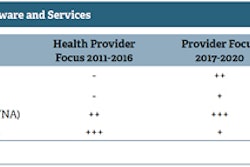
ORLANDO, FL - Moving control of imaging informatics from radiology to enterprise IT can spark a real culture clash. However, IT service models used by chief information officers outside of healthcare can help smooth this transition, according to a talk at the 2014 Healthcare Information and Management Systems Society (HIMSS) meeting.
In the Wednesday talk cosponsored by the Society for Imaging Informatics in Medicine (SIIM), Dr. James Whitfill, chief medical officer at Scottsdale Health Partners in Scottsdale, AZ, shared how an IT-based service management approach dramatically improved the situation at a large radiology practice.
Radiology and enterprise IT departments have dramatically different perspectives, which can lead to challenges during the ongoing transition of imaging informatics support to the enterprise IT domain. But there is much they can learn from each other, Whitfill said. IT service management models can help bridge this gap.
A fragmented past
Modern health informatics, which began with an initiative at Cleveland Metropolitan General Hospital in 1968, started to fragment into departmental and ancillary information systems with early commercial offerings in the 1980s to 1990s, Whitfill said. In the mid-to-late 1990s to early 2000s, PACS achieved wide acceptance, rapidly replacing film.
While adoption of electronic medical records (EMRs) finally began to heat up in 2010, PACS has become a mature and stable market, moving out of the world of radiology and into the world of enterprise IT.
PACS technology developed differently from other clinical information technologies, Whitfill said. It often had a separate environment from IT, with its own separate network, support staff, and storage. Unlike a lot of other clinical IT systems that developed from a software background, PACS draws more of its lineage from the imaging modality space, he said.
"That legacy still continues today in terms of creating an environment where a PACS feels like it's different from other IT systems in an institution, even though it's not," he said.
PACS were very tightly linked to clinical staff, including physicians and technologists. Sometimes technologists even became PACS administrators.
"They're not always schooled in hardcore IT system management and systematic approaches, but they tend to be very responsive to yelling physicians and doing whatever the physicians are asking them to do," he said. "There's good and bad that comes with that."
Growing up
PACS evolved to become enormously successful, but it began to outgrow its status as a departmental system due to issues including scale, popularity among other specialties, regulations such as HIPAA, and the transition of radiology from a revenue center to a cost center.
"Radiology is having to do more with less," he said. "As you're forced to reduce your costs, whether it's from a storage perspective or from an infrastructure perspective, that is a challenge that can be difficult for a department to meet. The enterprise is more well-skilled to do that."
The ongoing transition from the radiology department was evident in results from a survey at SIIM 2013. About 30% reported PACS was fully supported by their enterprise IT department, while 37% said PACS support still remained in their radiology department. An additional 26% reported a mix between the two departments, and 7% indicated "other," which was mostly outsourced support, Whitfill said.
"I'm going to guess, as we measure this over time, we'll continue to see the trend of more and more PACS systems being completely managed by enterprise IT," he said.
No longer the favorite son
This shift of PACS to enterprise IT can induce fear and anxiety in the radiology department. Radiologists need to understand that the world has changed, and they're no longer the favorite son, Whitfill said.
Radiologists used to dominate a lot of the IT decisions within the hospital, but that's not happening anymore; this can be a hard adjustment for them. Chief information officers (CIOs) also have other priorities right now.
"CIOs today are worried about things like virtualization, security, strategy," he said. "For the most part, they see imaging in the radiology department as a mature technology. 'It's been done; it's in a maintenance phase.' "
In other results from the SIIM survey, respondents named the following as the most important IT projects at their institution:
- Electronic medical records: 37%
- Meaningful use: 22%
- Imaging: 18%
- ICD-10: 12%
- Other: 8%
- Computerized physician order entry: 2%
This means that 81% of the most important projects were not imaging, Whitfill said.
"The reality is that [for] the next upgrade to the PACS or a special workflow layer, there are just no resources left in the organization to manage these types of things," he said. "We can't expect the CIOs and IT department to be at our beck and call to do whatever we want to do, because they have a lot of other important things to focus on."
Enterprise IT fears
For their part, enterprise IT departments can have their own fears about taking on support for PACS.
"There's nothing more frightening than having a shadow IT department running in your organization, and you don't even know what they're doing," he said. "They may be really focused on making sure the radiologists are happy, but they're not patching their service, they're not worried about HIPAA compliance, they're not worried about all of these other regulatory things, and they may not be worried about business continuity. There's nothing worse than when something goes really wrong and a CIO is held accountable for a rogue group that's been going on in radiology."
Both groups need to learn from each other and understand each other's perspectives, Whitfill said. There's also some common ground between the two departments. While CIOs are focused on process, governance, and a systematic approach to IT, they also care about innovation and efficiency, as do radiology departments.
IT service management
As institutions grow, the resulting increase in complexity and change can lead to a drop in IT responsiveness levels. Although it's not familiar to many in the radiology world, the traditional IT concept of IT service management (ITSM) is a means of increasing service levels, system uptimes, and satisfaction through a very focused approach to IT, Whitfill said.
One framework to ITSM, called an IT infrastructure library (ITIL), comprises a number of processes: incident, change, configuration, capacity, problem, and project management.
Whitfill shared how ITIL practices were used to great success at Southwest Diagnostic Imaging (SDI), a group of 97 radiologists reading approximately 2 million imaging exams a year in Arizona.
As SDI experienced rapid growth and later merged with another practice, IT support began to struggle.
"We began to see -- and this is pretty typical as a departmental approach begins to fail -- that this increasing complexity and increasing decentralization of teams starts to lead to failures," he said.
As SDI's CIO, Whitfill increasingly began collaborating with nonhealthcare CIOs to learn their approach to high IT service levels, and he became convinced that ITIL could really benefit the organization. To bring ITIL concepts to private radiology practice, Whitfill sent SDI's director of information systems to attend ITIL classes and receive certification.
After starting with an inventory of SDI current practices to ascertain alignment and any gaps with ITIL core publications, the group worked to fill the most pressing gaps with new ITIL-inspired processes. They adopted an IT department management system inspired by ITIL and adopted ITIL goals to match local processes and culture.
Change management
SDI hoped that the concept of change management and creating a change management database would allow the IT department to respond to situations more rapidly.
"We found that things got a lot better, but not because we could quickly go to a change management database," he said. "But once we forced people to go through the change management process and think about the steps of what they are doing ... all of a sudden people got a lot more serious about changing things, and they didn't just change things on the fly. It was amazing -- the quality of our uptimes all of a sudden came back up."
Developing an IT service catalog also eased training. The catalog included all of the services offered by the IT department, and it "identified what we did, how we did it, and who can ask for it," Whitfill said.
"After ITIL, we can tell our server managers that if you go and reboot this server in the middle of the day, it will stop these DICOM services and now images can't come into the PACS," he said. "Physicians can't view those images and patient care is impacted."
There's so much that radiology can learn from enterprise IT and a concept like ITIL, Whitfill said.
"When you have a solution that now scales up to the entire enterprise, you can take a structured, systematic approach to managing it, and it can dramatically improve the quality and uptime of service without putting in a lot of bureaucracy," he said. "For those of you who are in the radiology world, understanding concepts like this can help you bridge the gap with your colleagues in the enterprise IT space."
Those in the enterprise IT department can also leverage the radiology department's knowledge of the imaging process and imaging workflow, which can be useful as imaging informatics moves out into the other "-ologies," Whitfill said.




















